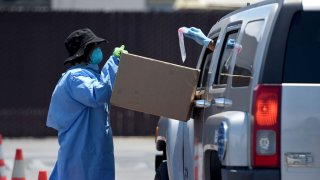
With coronavirus cases rising fast, California overhauled its guidelines Tuesday for who can be tested, prioritizing people who are hospitalized with symptoms, those in close contact with infected people or when necessary to control an outbreak.
The new guidelines say people without symptoms and not in essential jobs won't be prioritized for testing until results can be turned around in less than 48 hours. Spokespeople for the state health department didn't respond to a question about the current average wait time.
The changes come as the state faces testing shortages and long wait times for results as new outbreaks pop up around the state. Los Angeles County, home to a quarter of the state’s population, reported a record 4,244 additional cases on Tuesday. Nine percent of people tested in the county are positive for the virus, higher than the state's rate of 7%.
To stem the surge of cases, Gov. Gavin Newsom on Monday closed malls, hair salons, gyms and other indoor businesses in most of the state, and barred inside religious services.
“This is all done while we are in parallel working to increase testing capacity across the state," said Dr. Mark Ghaly, secretary of the California Health and Human Services Agency.
The new testing methods are designed to help California zero in on outbreaks spread among essential workers or by gatherings of family and friends. Getting test results more quickly in areas of potential outbreak is important to the state's ability to contain the spread, Ghaly said.
Dr. Hala Madanat, director of the School of Public Health at San Diego State University, said the new rules make sense given the limited availability of testing. She said she's heard of people who have symptoms waiting several days to get tests, which makes it harder to control the spread.
Local
Get Los Angeles's latest local news on crime, entertainment, weather, schools, COVID, cost of living and more. Here's your go-to source for today's LA news.
“It would be ideal if we had all these tests approved and available and we could test all the asymptomatic people and do surveillance, but it's not realistic at where we are right now in the supply chain," she said.
Meanwhile, the state's increased transmission level has made contact tracing harder, Ghaly acknowledged. About 7,800 people are testing positive a day, and the state has 10,000 contact tracers reaching out to people who have been in close contact with infected individuals. The state is testing about 107,000 people per day.
“We did not build the current contact tracing program on this level of transmission," Ghaly said.
California's old testing guidelines, introduced May 1 when the virus was under much better control, had just two tiers. The first included hospitalized patients, health care workers, people over 65, those in nursing homes, workers at essential businesses like grocery stores and lower risk people with symptoms. Tier two included only lower risk people without symptoms.
As testing expanded and California initially avoided its expected surge, cities including Los Angeles and Sacramento opened testing to anyone, regardless of symptoms.
That's no longer a priority as resources are spread thin and as the state's transmission rate increases. Under the new system, the highest priority is only on hospitalized patients with symptoms, those in contact with people who have confirmed cases and to manage outbreaks at the direction of local and state health officials.
The second tier includes anyone with symptoms or asymptomatic people who live in congregate care settings such as nursing homes, care for the elderly, or work in emergency services or a jail or prison, and patients entering or leaving hospitals. The third tier includes workers in retail, manufacturing, food service, agriculture, public transportation and education.
- Stay home when ill
- Wash hands frequently
- Plan ahead for possible social disruptions, like event cancellations and postponements
- Pregnant women, individuals with underlying health conditions and older people should practice social distancing and avoid being in close contact with others who are ill
Other asymptomatic individuals who think they are at risk are in the fourth and lowest tier. Testing will only be given to those individuals once the state can turn around results in less than two days, according to the guidance.
Beyond the new guidelines, Ghaly said the state is writing emergency regulations to make sure health insurance companies cover all coronavirus testing in the state — especially for “essential” workers at greater risk of contracting the disease. The regulations have not been released.
California health plans already cover testing at no cost to the patient if that testing is ordered by a physician, according to the California Association of Health Plans. Federal guidelines do not require health plans to test for employment purposes or for public health surveillance.
“We will work with the Administration to determine how today’s announcement changes our current practice. The details around this will matter,” the association said in a statement.



